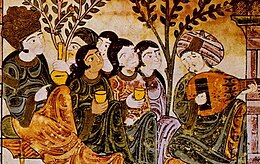Basit
| Part of a series on |
| Arabic culture |
|---|
 |
Basīṭ (Arabic: بسيط), or al-basīṭ (البسيط), is a metre used in classical Arabic poetry. The word literally means "extended" or "spread out" in Arabic.[1] Along with the ṭawīl, kāmil, and wāfir, it is one of the four most common metres used in pre-Islamic and classical Arabic poetry.[2]
Form of the metre[]
The metrical form of the basīṭ is often as follows (where "–" is a long syllable, "u" is a short syllable, and "x" is anceps, i.e., a syllable which can be either long or short):[3][4]
- | x – u – | x u – | – – u – | u u – |
The mnemonic words (tafāʿīl) used by Arab prosodists to describe this metre are: Mustafʿilun Fāʿilun Mustafʿilun Faʿilun (مُسْتَفْعِلُنْ فَاعِلُنْ مُسْتَفْعِلُنْ فَعِلُنْ).
The metre is usually used in couplets of eight feet each.
Example[]
An example is the qasīda by al-Mutanabbi (915-965): “The poet reproaches Sayf al-Dawla” (king of Aleppo), a poem of 38 couplets, from which comes the well-known verse:
- إذا رَأيْـتَ نُيُـوبَ اللّيْـثِ بـارِزَةً * فَـلا تَظُـنّـنّ أنّ اللّيْـثَ يَبْتَسِـمُ
- ’idā ra’ayta nuyūba l-layti bārizatan
- falā taẓunnanna ’anna l-layta yabtasimū
- | u – u – | u u – | – – u – | u u – |
- | u – u – | – u – | – – u – | u u – |
- "If you see the lion’s fangs displayed,
- do not imagine for a moment that the lion is smiling."
Variations[]
Although in the poem of al-Mutanabbi quoted above, the last foot of each half-verse is always | u u – |, other poets use the metre in the following form, where "uu" represents a biceps element, i.e. one where the two short syllables can optionally be replaced by one long one.
- | x – u – | x u – | – – u – | uu – |
An example is the following drinking-song by Abu Nuwas which begins:
- دَعْ عَنْكَ لَوْمي فإنّ اللّوْمَ إغْرَاءُ * ودَاوني بالّتي كانَتْ هيَ الدّاءُ
- daʿ ʿanka lawmī fa-’inna l-lawma ’iḡrā’u
- wa-dāwinī bil-latī kānat hiya d-dā’u
- | – – u – | – u – | – – u – | – – |
- | u – u – | – u – | – – u – | – – |
- "Censure me not, for censure but tempts me;
- cure me rather with the cause of my ill—"[5]
The metre also exists in a trimeter form of which the half-verse is as follows:
- | x – u – | – u – | x – u – |
There is also a catalectic trimeter form:
- | x – u – | – u – | x – – |
Occasionally the first foot of each half-verse can be | – u u – |.
Very rarely (in less than 1% of lines) the 3rd foot can be | u – u – |.[6]
In a musical context[]
The term basīṭ is also used in a musical context; in the Andalusi nubah, or classical suites, of Morocco, each nubah, or suite, is divided into five main movements (called mīzān (ميزان; plural: mawāzīn, موازين)) each of which uses a different rhythm, as follows:
- Basīṭ (6/4)
- Qāim wa nusf (8/4)
- Btāyhī (8/4)
- Darj (4/4)
- Quddām (3/4 or 6/8)[1]
See also[]
References[]
- ^ Edward W. Lane (1863) Arabic-English Lexicon Archived 2015-04-08 at the Wayback Machine.
- ^ Golston, Chris & Riad, Tomas (1997). "The Phonology of classical Arabic meter". Linguistics 35 (1997), 111-132; p. 120.
- ^ McCarus, Ernest N. (1983). "Identifying the Meters of Arabic Poetry", Al-'Arabiyya vol 16. no. 1/2, pp. 57-83. (Georgetown University Press).
- ^ Wright, W. (1951). A Grammar of the Arabic Language, vol. II, Cambridge University Press; pp. 350-390.
- ^ Translation from Kennedy, Philip F. (1997). The wine song in classical Arabic poetry: Abu Nuwas and the literary tradition. Oxford University Press.)
- ^ Stoetzer, Willem (1982) "Some Observations on Quantity in Arabic Metrics". Journal of Arabic Literature Vol. 13 (1982), pp. 66-75
External links[]
- A recitation in Arabic of al-Mutanabbi's line
- Chanted version of al-Mutannabi's poem. The quoted line is at 2:31.
- Recitation of the Abu Nuwas poem by Bashar Al-Roumi
- Version of the Abu Nuwas poem sung to a lute
- Arabic and Central Asian poetics
- Poetic rhythm
- Arabic music
- Arabic poetry
- Arabic poetry forms